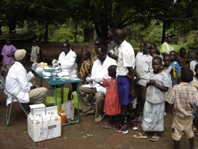This led to a significant decrease in the subsequent number of cases reported. As a result, most organizations progressively stopped their activities after 2006 as it became difficult to advocate for internal and external resources for what no longer appeared to be a serious problem.
Comparing the five years following the departure of most nongovernmental organizations (2006–2010) with the previous period of peak nongovernmental organization presence (2001–2005) reveals a 47% decrease in the number of people screened (from 399 977 to 211 946) and a 71% reduction in the number of new cases reported (from 8664 to 2475).
In 2011, only 0.4% of the 1.8 million population living in the endemic areas of Greater Equatoria State were screened for the disease.
Active screening is crucial in order to diagnose patients at an early stage of the disease because those infected and not being treated act as a reservoir maintaining the transmission cycle. The percentage of screened people who underwent active screening was 70% in 2006 and fell to 8% in 2010.
The dwindling of interventions for sleeping sickness control could lead to a new epidemic. In fact, a resurgence is already occurring as evidenced by the figures for 2011 where the number of cases reported is 1.45 times higher than the previous year (from 180 in 2010 to 261 in 2011).
This was foreseen in an article published by WHO at PLoS Neglected Tropical Diseases: Human African trypanosomiasis in South Sudan: How can we prevent a new epidemic?
Unless urgent action is taken to improve sleeping sickness control in South Sudan, another devastating epidemic could kill thousands of people.
Although a number of stakeholders have supported sleeping sickness interventions in South Sudan in recent years, more still needs to be done. The commitment and involvement of health authorities and local communities is a crucial factor in attaining a sleeping sickness-free nation. The involvement of international organizations to support human African trypanosomiasis diagnosis and treatment is also very important.
However, this is not possible without additional resources to support the expansion and coverage of treatment centres and to facilitate more active screening campaigns in the country. Resources are also required to support the purchase of medical and nutritional supplies.








 6 June 2012 – Human African trypanosomiasis, also known as sleeping sickness, is currently on the rise in South Sudan. The disease is transmitted by tsetse fly and is 100% fatal without treatment. It is endemic in Greater Equatoria State.
6 June 2012 – Human African trypanosomiasis, also known as sleeping sickness, is currently on the rise in South Sudan. The disease is transmitted by tsetse fly and is 100% fatal without treatment. It is endemic in Greater Equatoria State. 